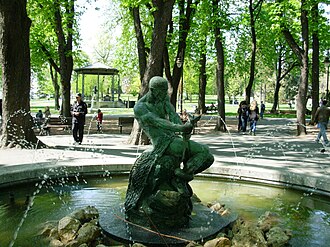Fishing fountain (Belgrade)
| Fishing fountain Фонтана Рибар (Борба) or Злосретни рибар |
|
|---|---|
| The fishing fountain | |
| place | Belgrade |
| country |
|
| construction time | 1906 |
| sculptor | Simeon Roksandic |
| Coordinates | |
| location | Coordinates: 44 ° 49 '14.1 " N , 20 ° 27' 6.8" E 44 ° 49 '14.1 " N , 20 ° 27' 6.8" E |
The Fisherman's Fountain (Serbian Фонтана Рибар (Борба) or Злосретни рибар ) is a fountain on the main roundabout of Kalemegdan , a park on the former glacis of the Belgrade Fortress in the Serbian capital Belgrade . It is the work of the sculptor Simeon Roksandić .
The sculpture was created in 1906 during a one-year vacation of the artist, who was a drawing teacher at the grammar school in Kragujevac , in Munich and Rome . It was launched in 1907 on the LXXII. International art exhibition in Rome presented to the public, where it found place in the first and most important exhibition space and in Italy to positive criticism, u. a. of the Italian royal couple. The Serbian cultural elite also recognized the value of sculpture, which soon became part of the Serbian cultural space. The plaster model, consisting of the figure of a fisherman and a snake, was bought by the Serbian National Museum in 1907. The fisherman's sculpture was presented as a key artistic artifact in the Serbian pavilion at the 1907 Balkans Exhibition in London .
Effect of the sculpture and another cast
The figural composition of a fisherman fighting the snake quickly became a symbol of the young Serbian state and a metaphor for its cultural progress and its progressive understanding of the development of art.
When the false news that the ship with the works of art had sunk on the way to England reached the Serbian public, another figure was cast based on the plaster model. After the return of the Serbian exhibits from the London exhibition, there were now two sculptures, so that the city of Zagreb bought the second model after the third exhibition in 1908 and set it up in Grič (today Jezuitski trg in the Gornji grad district ).
To the location
Roksandić offered the first model to the city of Belgrade for sale, which was done in 1907 with the intention of placing it on one of the city squares. Contrary to what was planned, the fountain was not placed on Terazije , but on Kalemegdan (between 1908 and 1911). The photographic illustration in the magazine Nova iskra from 1911 confirms that the sculpture was in Kalemegdan Park at that time and was already one of the most recognizable monuments in the city. The existing oval fountain with a rustic stone pedestal on the central rotunda of the Great Kalemegdan Park was chosen as the installation site. From the opening in 1867 to the beginning of the 20th century, the square had developed into a representative city park and thus offered excellent spatial conditions for the installation of public sculptures.
The original idea for the spatial design of the park grew out of the regulatory plan by Emilijan Josimović , which provided for the creation of a city park in the area of today's Kalemegdan, the former fortress glacis. The first known document about the design of the park is included in the plan with the label "copied from the plan of Belgrade from 1870". The first architectural composition was created by the architect Milan Kapetanović in 1890, which was retained until 1914. The main feature of Kapetanović's solution is the alignment of straight paths from the direction of Knez Mihailova Street with a central rotunda, in which the fisherman from Roksandić is placed, creating a visual transversal to the city. The park in its current form was created at the end of the 19th and beginning of the 20th century with features of a representative park of the fin de siècle . The concept is implemented in the manner of the city parks of European metropolises. At the end of the 20th century and from 1894, when the bust of Đuro Daničić was erected, the process of placing public sculptures in the park began.
style
The sculpture is a classic work of European sculpture , the fruit of artistic and cultural life in Munich, which also included Simeon Roksandić as a graduate of the local art academy . After completing the trade school in Zagreb and taking lessons in sculpture at the Pest Academy, Roksandić enrolled in the class of Professor Syrius Eberle at the Munich Art Academy in 1892 . The study visit to the capital of Bavaria had a lasting influence on the artist's career, while restorative and conservative work on public sculptures in Munich shaped Roksandić's development path.
Looking back in 1940, Roksandić emphasized in a conversation with Zvonimir Kujundžić : "I formed the fisherman out of the need to show the victory of man over the forces of nature with symbols."
The fishing fountain is one of the cultural assets of special importance in the Belgrade Fortress (decision on the determination, Official Gazette “Službeni glasnik SRS” No. 14/79).
Web links
Individual evidence
- Igor Borozan: Obnova antike i arhajski modernizam - fontana Ribar (Borba) Simeona Roksandića [= restoration of ancient and archaic buildings of the modern age - fishing fountain (fight) by Simeon Roksandić ], Nasleđe XV, Belgrade 2014, 33–46.
- Zora Simić-Milovanović: Simeon Roksandić 1874–1943 , Godišnjak grada Beograda IX-X, Belgrade 1962-63, 445–478. (pdf)
- Dokumentacija Zavoda za zaštitu spomenika kulture grada Beograda (= Documentation of the Institute for Monument Protection , Belgrade)

